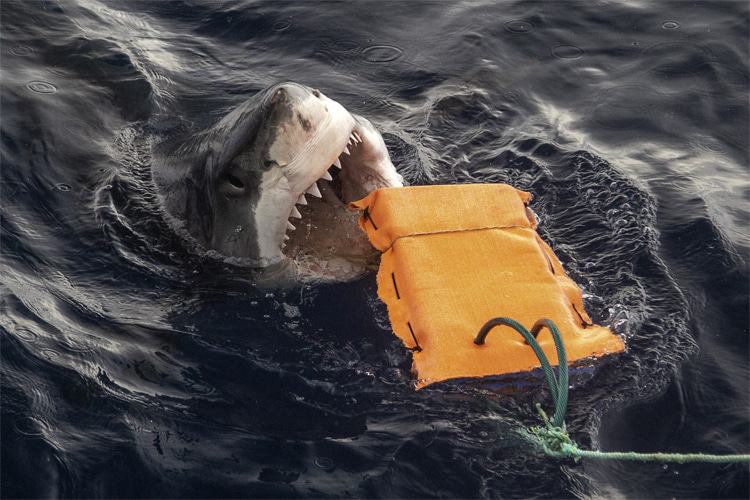
Surfers and swimmers are among the groups of humans that more often face sharks, and when they do, the consequences can be severe.
Australian scientists from Flinders University have now put near “shark-proof” wetsuit fabrics to the test, biting into them with live sharks, to see if new materials can cut down the damage.
But these fabrics aren’t medieval-like chainmail. They’re actually wearable materials.
Modern wetsuits could soon incorporate ultra-strong fibers like Kevlar and Dyneema (ultra-high-molecular-weight polyethylene) as an interesting protective layer to stop big predators while still letting surfers move, paddle around, and catch waves.
In the 1970s, chainmail shark suits gave divers extra protection, but they were heavy and stiff.
Innovative Fabrics in Wetsuits
The future of anti-shark bite wetsuits uses different approaches. Four cutting-edge fabrics were tested:
- Aqua Armour: a modern chainmail-style system with metal link pads layered inside neoprene panels;
- Brewster material: a web of Kevlar fibers fused with polyurethane, sandwiched in neoprene;
- Shark Stop: ultra-high-molecular-weight polyethylene (UHMWPE) fibers (think Dyneema/Spectra) woven into a rubber wetsuit lining;
- ActionTX-S: another UHMWPE fabric (Dyneema-based) woven into flexible Yulex rubber neoprene;
To see if these materials really work, researchers baited 28 great white sharks and eight tiger sharks to bite dummy targets covered with either plain 3-mm neoprene (the control) or one of the four test fabrics.
Across 19 days, they recorded 84 bites from white sharks (2.4-4.5 m long, mean 3.6 m) and 68 bites from tiger sharks (3.0-4.3 m, mean 4.0 m).
By comparison, a grown great white’s bite can tear open areas up to a square meter in size.
Every bite was scored for damage:
- Tiny surface grazes (C1);
- Slight cuts (C2);
- Deep lacerations (C3);
- Critical blood-gushing wounds (C4);

Great White and Tiger Sharks Bite Tests
Here are the bite-resistant test results for the two most common shark species involved in unprovoked attacks.
Great White Sharks
On plain neoprene, about 8 percent of the bitten area was “substantial damage” (C3), and 3 percent was critical damage (C4).
With any of the protective fabrics, C3 dropped to less than 1 percent, and C4 was virtually 0 percent.
For example, one suit (Aqua Armour) cut C3 damage from 8±1 percent (that is, between 7-9 percent) down to <1 percent, and no critical cuts were seen at all on it (though only four bites were recorded on that suit).
All four materials performed similarly for severe wounds; each sharply cut deep cuts and punctures compared to plain neoprene.
Tiger Sharks
Plain neoprene saw about 6±1 percent of a bite in C3 damage.
With suit materials, that fell to 2±1 percent on Shark Stop and 1±0.3 percent on ActionTX-S or Aqua Armour.
Tiger bites on neoprene made up to 1 percent critical damage, but no C4 wounds occurred on any bite-resistant material.
In short, each fabric drastically shrank the area of serious cuts and gashes.
The study noted larger tiger sharks – those over ~4 m – naturally did more damage, but even the biggest bites were blunted by these suits.
Exciting Results and Hopeful Conclusions
The tests show that bite-resistant wetsuits can tremendously reduce life-threatening injuries. That’s the first major takeaway.
All fabrics significantly lowered deep lacerations and punctures (C3 and C4), the kinds of wounds that cause massive bleeding.
Superficial scratches (C1 and C2) were a bit more common on one material (Shark Stop), but those are minor bruises compared to what normally would have been a serious cut.
And that’s an absolutely extra victory. In effect, shark bites that might normally gut a victim were turned into much smaller wounds.
As the authors of the research led by Thomas M. Clarke explain, the gear turns potential bleeding crises into “minor wounds” that heal faster.
Not all fabrics are equal in feel and flexibility, though.
The chainmail-based Aqua Armour did best at stopping cuts (it showed the least C3 damage and no C4 cuts), but even the authors admit it’s stiff.
It’s the “least flexible” of the lot and felt rigid in tests. Fair enough.
The Kevlar weave (Brewster) is also very protective but would need careful placement on a suit.
By contrast, Shark Stop and ActionTX-S use Dyneema-like fibers woven into a stretchy rubber (Yulex) lining. These still block bites well, but let the wetsuit bend and move more naturally.
It’s the Surf industry’s Turn, Now
In practice, wetsuit manufacturers could put rigid panels where it matters (torso and femoral artery) and softer neoprene on joints to balance safety with performance.
Surfing is never 100 percent safe, but this study gives wave-riders new data on what wetsuits can do.
And this could be particularly relevant in the most shark-infested waters of the planet, where surfers have been particularly targeted: Florida, Australia, South Africa, and the Maldives.
Bite-resistant suits won’t stop a great white from taking a bite, but they can buy valuable seconds and reduce blood loss when it does happen.
As the scientists conclude, these modern materials “offer an improved level of protection” and “should be considered” part of the shark-bite safety toolkit.
For ocean-goers hoping to ride rather than run from sharks, that extra layer of defense could make all the difference.
Hopefully, spin-offs from this research could be picked up by the surf industry to develop a new generation of wetsuits.
Words by Luís MP | Founder of SurferToday.com


Leave a Reply